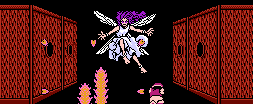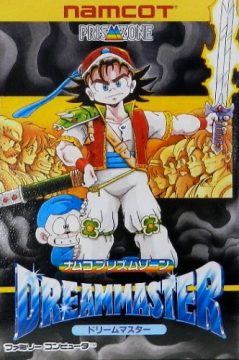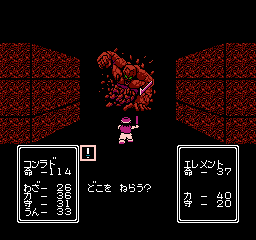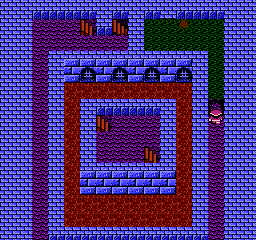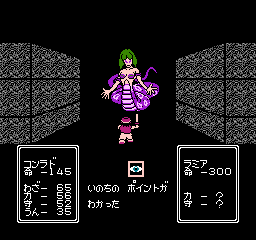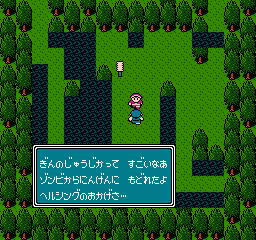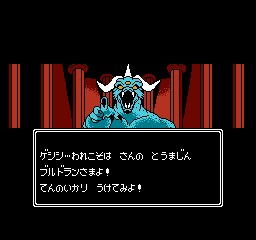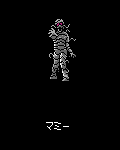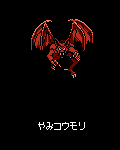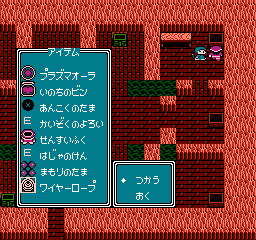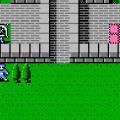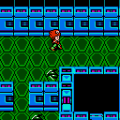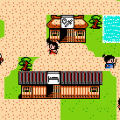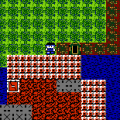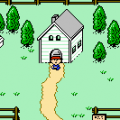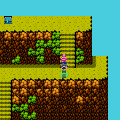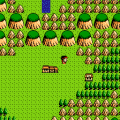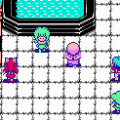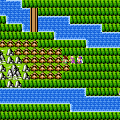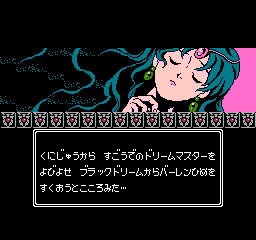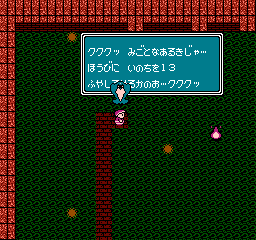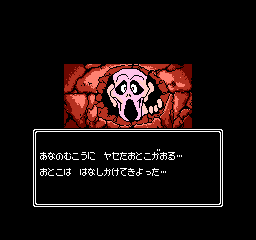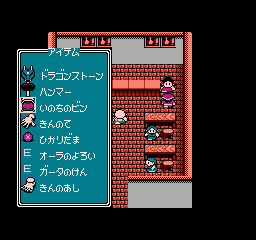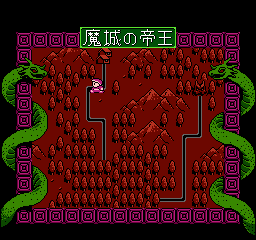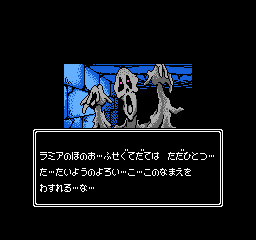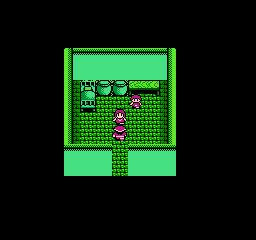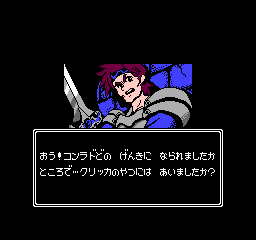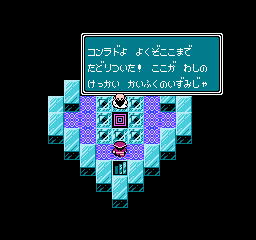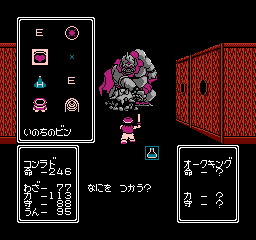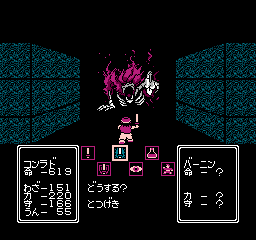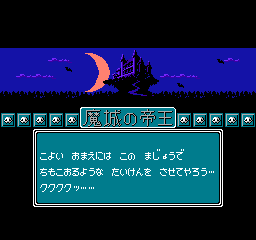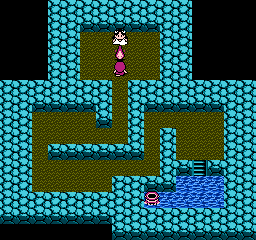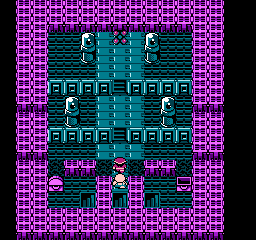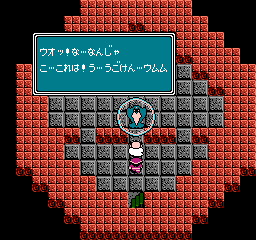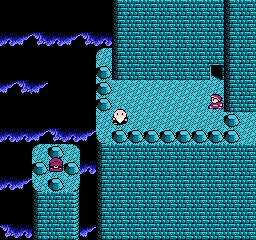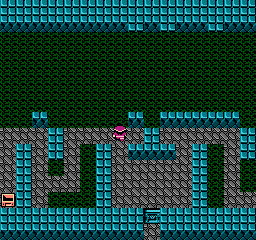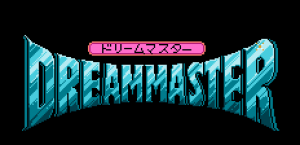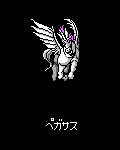Peace and harmony in the kingdom of Oltaria come to an end when an evil old man known as the Black Master seizes the soul of King Akinas’ young and beautiful daughter. The sixteen-year-old princess (whom you get to name) is drawn into the Black Dream, a world of nightmares crafted by the evil wizard. Profoundly grieving over the ill fate of his only daughter (a neverending sleep destined to end in death), the king gathers the best “dream masters” from all over the country: wizards with funny names like Krikka and Jaja who are able to go deep into the soul of people to bring them peace. However, of all dream masters who attempt to save the princess, nobody is able to return. As the young pupil of the most powerful dream master of the kingdom, the “mugenroushi” (the Sage of Dreams), too old and weak to handle the problem himself, you are the last hope to venture into the Black Dream and save the princess, defeat the Black Master and bring back the other masters kept prisoners within the nightmare world.
While at first glance Dream Master could simply be classified as a JRPG, its gameplay is in fact rather atypical and features puzzle, adventure and action elements. As explained in the initial chapters by the Sage of Dreams himself, rooms in the nightmare world are engulfed by a magic mist, so that you cannot see the walls, items or enemies inhabiting the Black Dream. These blind dungeons mostly consist of single-screen areas seen from above, whose tiles reveal as you walk into them; bumping into walls consumes energy points, yet there is no way to determine whether the tile you’re going to uncover will contain a wall or not, so it’s a matter of chance most of the time (there are cases where you can assume the room has some sort of symmetry, which you can exploit to keep collisions to a minimum). Not all the rooms are completely covered by the dark haze, and treasure boxes are usually clearly visible, since they emanate a pulsating light beneath the fog. Monsters are completely hidden, but their presence is signaled within 2-3 blocks by a rustling (“gasagasa”) sound, and at times their actual position is revealed by a short-lived sprite of a small flame. Monsters do actually move around so it can be difficult to avoid them completely (not that you’d actually try to do that). Likewise, traps (of the pitfall type) are signaled by a blowing (“hyuuhyuu”) sound. Spread across the rooms in the dream world are various items, including door keys, potions and special combat items, yet your limited inventory will allow you to carry only eight objects at a time. Luckily, you’re given the option to drop items and retrieve them later on should the need arise. Some of the items found in the dungeons are necessary for the story to unfold and are needed for various inventory-type puzzles.
The puzzle element is, in fact, rather strong in Dream Master. Every level has a number of puzzles to solve, and these range from simple inventory items being used properly, to slightly more complicated password-like door opening riddles that will leave you scratching your head more than once. A few of these puzzles are skippable in that you’re free to accept taking some damage in place of avoiding some trap, but most of the time it’s either utterly inconvenient or just impossible. Also, hidden passages are often found and all of them are necessary for game progress; you’ll also have to find them quickly before the scorching flames of inferno consume you. Accompanying these puzzle parts, strategy also plays a role. Since most stages are rather short, comprising a few enemies and a handful of rooms, you’ll have to step carefully to avoid entering the difficult areas too early and without proper equipment. The items you keep and those you drop, where and when, should be carefully thought over, especially in the later levels.
The combat system also differentiates itself slightly. First, since enemies manifest themselves through sounds, encounters are semi-random and avoidable to some extent. In addition, there is only a limited number of monsters for each map and they do not respawn. Level grinding is thus non-existent, and the limited number of encounters naturally creates an experience cap for the player. Experience is measured in “waza” (technique) points, while health is measured in “ener” points. A “class-up”, which increases the only two available attributes (strength and defense), is achievable after a predetermined and clearly shown amount of waza has been reached. Battles are in a third-person perspective seen from behind the shoulders of the main character, so you can see the enemy face-to-face. Enemies range from your typical RPG beasts (zombies, pirates, knights, electric fish, etc.), to totally weird creatures such as a jack-in-the-box binding your legs and a huge burning crucifix cursing you with flying skulls. Monsters always fight alone and have static sprites, usually turning to a flashing color when they attack. On the other hand, the player is fully animated for each available action.
Combat is turn-based, and you can decide whether to run away or go for a simple, “constrained” or charge attack. While simple attacks have a balanced hit ratio, constrained attacks deal less damage but also absorb more from the enemy. Similarly, charges deal a lot more damage, but have a much lower hit ratio and leave you open to subsequent attack from the other side. Every battle is given a seemingly random “luck” attribute, which varies the hit, dodge and evade ratios. For instance, you may want to attack with constrained strikes if the luck stats are low, whereas charges will be highly effective if luck is on your side. That being said, I’ve personally cared about luck stats only much later in the game, and even then, managed to get to the end almost painlessly. Attacks require you to indicate a specific part of the body to hit. As such, each monster has a weak point which can be revealed through a “search” command, together with its current health, attack power and defense. The real fun, though, comes from the various combat items that can be collected in the dungeons. Most of them are of a magical nature, and even if they do not deal more damage than a direct sword or whip attack, they make the fights much more dynamic and interesting to watch. A dragon stone, for instance, will transform you into a little, fire-breathing dragon, while by using a mysterious lamp you’ll be able to invoke the well known genie to fight alongside and throw flames at the foe. Likewise, monsters will throw both direct and special attacks at you, with the latter triggering a reaction system where you are given a chance to dodge the attack by quickly moving in a direction. The success rate is out of your control, but battles turn out to be more engaging with this hybrid combat system.
Unless you’re bringing a “life jar” along (a special item acting like an extra life when you’re defeated during combat), death is permanent. When this happens, you are brought back to the real world by the Sage of Dreams, who is constantly watching over your sleeping body. You lose all your items and experience gained in the dream world, and you have to restart the level from the beginning. However, this kind of penalty is not very punishing, since levels are fairly short on average and making the game restorable in the middle of a dream would probably make it far too easy to beat. Progress is saved by means of simple passwords called “dreamwords”, which are given by the mugenroushi at the end of each level. Since there is no experience or items to care about in the real world, the passwords are simple, four-syllable dictionary words, preceded by the names of your two characters. This simple set-up makes the dreamwords feel like magic spells used by the Sage to move your soul to specific dreams, further helping to pull you into the atmosphere of the game’s setting.
Dream Master is divided into seven chapters, each corresponding to a new dream and coming with its own title (such as “Emperor of the Magic Castle”); these chapters usually consist of a new village to visit and one or more bosses to destroy. At the beginning of each dream, the Black Master is kind enough to inform you of the various beasts you’ll encounter. You’ll also get to meet the previous dream masters, still trapped in the Black Dream, who will sometimes join forces with you; they will fight along with you, but you will not have any control on their actions during combat. Finally, every level contains a special room representing a breach in the nightmare by hand of the Sage of Dreams, who will revitalize you and increase your maximum health, although only once per dream. Deciding when to visit this spring of health is part of the strategy in beating the level. The few game chapters are fairly short, taking on average less than one hour each to complete, and making for an unusually light experience especially with regard to other RPGs of the time.
Where Dream Master really shines, though, is in its amazing illustrations. Added to that is the fact that there is almost always something happening on screen: almost every screen has some event associated with it, and the game constantly finds ways to show some beautiful drawings, acting as either cutscenes, item depiction, NPC dialogues, and so on. There is one point where you’ll enter a coffin and be transported to the castle by a bat, and another where you’ll be witnessing the evil Lamia suck the youth out of an unlucky fellow. Or you’ll set sail, dive into the blue and jump around with your monkey companion. Considering the game only lasts a few hours, there’s plenty of fun to be had.
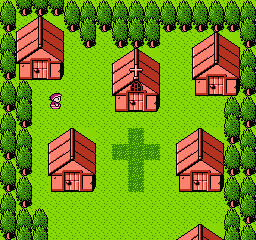 But it doesn’t come without its shortcomings. The dungeons themselves are not very varied, with almost every level requiring you to find and equip the powerful weapon of that area and unlock some door to face the boss, having explored everywhere. The game is not excessively linear, given that you’ll often be able to explore rooms and uncover treasures freely in the order you prefer, making for a different experience depending on your choices (going for a powerful enemy without having found the strong sword rather changes things!). This confers a decent amount of replayability to the game. Apart from that, most puzzles are immediate and all kinds of hints are provided even when it doesn’t seem necessary. The Black Master himself will often be there to help you in a mocking fashion (“Uhuhuh… You’ll never make it without this item!”), and will surprisingly reward you by increasing your health as you make some progress in the map without bumping into walls. The game manages to maintain a certain difficulty balance throughout the few levels. In later levels, enemies hit hard, but you also have more energy points and powerful weapons, making things equally balanced. Except perhaps for the last two levels, the game is rather easygoing and will not present major difficulties for most gamers.
But it doesn’t come without its shortcomings. The dungeons themselves are not very varied, with almost every level requiring you to find and equip the powerful weapon of that area and unlock some door to face the boss, having explored everywhere. The game is not excessively linear, given that you’ll often be able to explore rooms and uncover treasures freely in the order you prefer, making for a different experience depending on your choices (going for a powerful enemy without having found the strong sword rather changes things!). This confers a decent amount of replayability to the game. Apart from that, most puzzles are immediate and all kinds of hints are provided even when it doesn’t seem necessary. The Black Master himself will often be there to help you in a mocking fashion (“Uhuhuh… You’ll never make it without this item!”), and will surprisingly reward you by increasing your health as you make some progress in the map without bumping into walls. The game manages to maintain a certain difficulty balance throughout the few levels. In later levels, enemies hit hard, but you also have more energy points and powerful weapons, making things equally balanced. Except perhaps for the last two levels, the game is rather easygoing and will not present major difficulties for most gamers.
Following Kaijuu Monogatari and Juvei Quest, Dream Master was until very recently the third and last work by developers Birthday to be published by Namco (things changed in 2011 with the DS release Cocoro no Cocoron). Compared to the previous (rather hardcore) titles, the game features a refreshingly light system which Japanese gamers used to refer to as “Game Book RPG”, and which contributed in making the game quite popular. Although it only released in Japan, recently a full English patch has been made available by romhacker aishsha (get it here). It is probably one of the few hybrid RPGs of the time with a degree of replayability to it; if you have half an hour spare, you can just jump into the dream of your liking and confront dungeons in a different order or try some new items in combat. Dream Master is a refreshing alternative to the grind-heavy RPG library of the 8-bit consoles, and although you’ll almost breeze through it on the first playthrough, you’ll be glad to revisit it again from time to time.
It might be worth also mentioning, Dream Master for the Famicom should not be confused with Little Nemo: The Dream Master for the NES, which in Japan was called Pyjama Hero Nero (パジャマヒーロー NEMO).
Links:
Retro Game ga suki Full walkthrough in Japanese.
